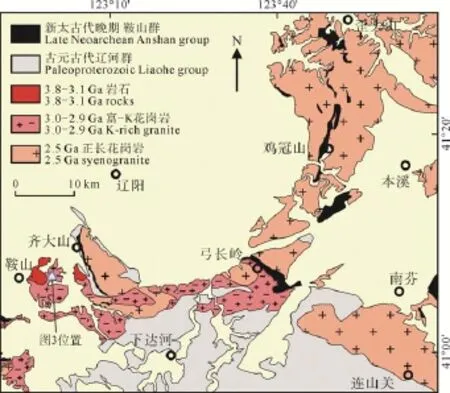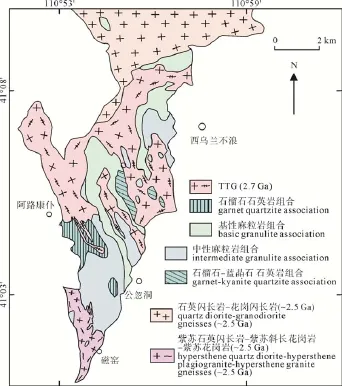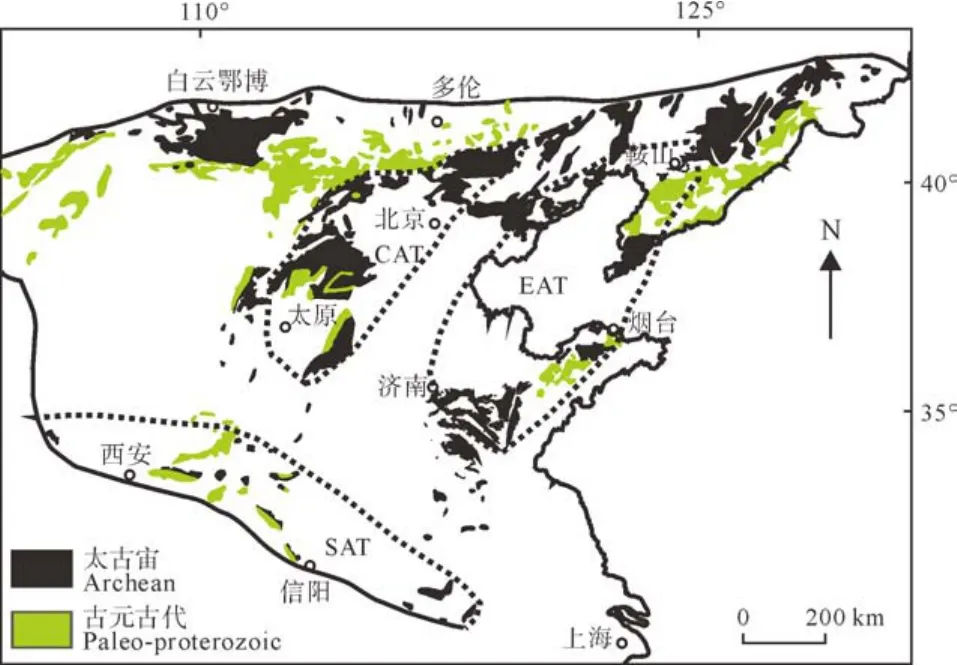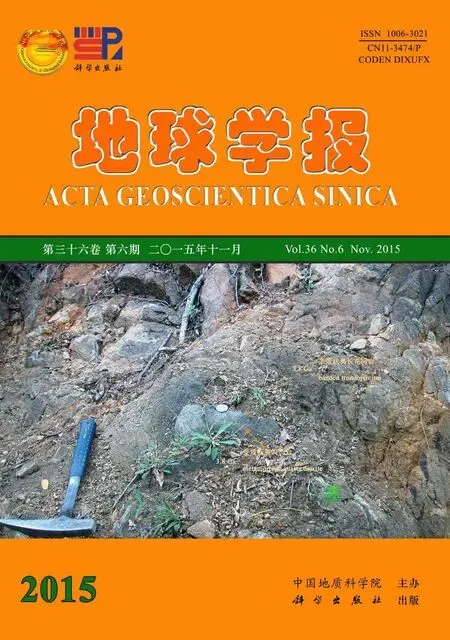华北克拉通太古宙研究若干进展
万渝生,董春艳,颉颃强,刘守偈,马铭株,谢士稳,任 鹏,孙会一,刘敦一
中国地质科学院地质研究所北京离子探针中心,北京 100037
华北克拉通太古宙研究若干进展
万渝生,董春艳,颉颃强,刘守偈,马铭株,谢士稳,任 鹏,孙会一,刘敦一
中国地质科学院地质研究所北京离子探针中心,北京 100037
华北克拉通存在3.8 Ga以上的地质演化历史。本文对近年来我们在鞍本、冀东、鲁西、胶东和阴山地区研究取得的进展作了简要介绍。在鞍山,深沟寺杂岩获得~3770 Ma,3600–3660 Ma,~3450 Ma,3310–3330 Ma和 ~3120 Ma锆石年龄,与白家坟杂岩和东山杂岩的岩浆事件十分类似。在冀东,对曹庄杂岩副变质斜长角闪岩和石榴黑云片麻岩定年,发现大量3.5–3.8 Ga 碎屑锆石,并获得 ~2.5 Ga变质锆石年龄,冀东地区很可能存在始太古代岩石,可把曹庄杂岩形成时代限定在2.5 Ga和3.4 Ga之间。在鲁西,把太古宙基底从东北到西南依次划分为A、B、C三个岩带: A带主要为新太古代晚期的壳源花岗岩,B带主要为新太古代早期的岩石,C带主要为新太古代晚期的新生岩浆岩。鲁西是华北克拉通新太古代早期岩石分布最广泛的地区,也是华北克拉通确认新太古代早期和晚期表壳岩系共存的唯一地区。在胶东,规模巨大的2.9 Ga岩浆热事件被识别出来,它是强烈地幔添加作用的产物。可能作为岩浆板底垫托作用的结果,2.9 Ga岩石与2.7 Ga岩石一道,在新太古代晚期(~2.5 Ga)遭受强烈变质改造。在阴山地块,除2.5 Ga表壳岩和侵入岩外,还存在2.7 Ga英云闪长岩和2.6 Ga花岗岩。新获得的资料表明阴山地块与华北克拉通东部陆块具有类似的早前寒武纪地质演化历史。还对华北克拉通太古宙变质基底的锆石年龄和Hf同位素组成及全岩Nd同位素组成进行了统计研究。结合前人工作,初步总结了华北克拉通太古宙地质演化特点。认为华北克拉通与其它克拉通类似,新太古代早期—中太古代晚期是陆壳形成增生的主要时期,但最强烈广泛的构造热事件存在于新太古代晚期。在我们新提出的构造区划中,划分出了三个古陆块(>2.6 Ga),即东部古陆块、南部古陆块和中部古陆块。
华北克拉通; 太古宙; 岩浆作用; 变质作用; 锆石定年; Nd-Hf同位素
华北克拉通是中国规模最大的克拉通,也是全球存在>3.8 Ga岩石的少数地区之一(Liu et al.,1992; Song et al.,1996; Wan et al.,2005,2012a)。>2.6 Ga岩石在华北克拉通广泛存在(图1)。然而,华北克拉通以存在强烈新太古代晚期构造岩浆热事件而闻名(沈其韩等,2005; Wan et al.,2011a; Zhai and Santosh,2011)。本文简单介绍了近年来我们在一些典型地区取得的主要研究进展和华北克拉通锆石定年和Hf同位素组成分析及全岩Nd同位素组成分析的统计研究结果,并对一些问题作了简要讨论。
1 典型地区
1.1 鞍本地区
鞍本(鞍山—本溪)位于华北克拉通东北部,早前寒武纪基底主要由新太古代晚期表壳岩系和花岗质岩石组成。新的研究进一步确定新太古代晚期花岗质岩石主要为正长花岗岩(图2)(Wan et al.,2015a)。正长花岗岩轻重稀土分异程度存在较大变化,但通常具有强的负铕异常,全岩Nd同位素和锆石Hf同位素组成表明它们形成于更古老陆壳物质的再循环作用。表壳岩(鞍山岩群)以不同但通常较小的规模存在于花岗质岩石中,以发育条带状铁建造(BIF)而闻名,成为我国最大型钢铁基地。近年来鞍本地区早前寒武纪研究的另一重要进展是在鞍山东部发现大范围分布的中太古代富钾花岗岩,它们与鞍山地区铁架山花岗岩的形成时代和组成特征十分类似,为铁架山花岗岩的东延部分(图2)(董春艳等,未发表数据)。
鞍山位于鞍本地区的西南部,已在多处发现3.8 Ga岩石,包括石英闪长岩和奥长花岗岩两大类。白家坟杂岩是最早发现3.8 Ga岩石(糜棱岩化奥长花岗岩)的杂岩(Liu et al.,1992),但之后的进一步研究表明该杂岩包括了3.1–3.8 Ga糜棱岩化奥长花岗质岩石和其它类型岩石,3.8 Ga岩石仅局部存在。东山杂岩也是由不同类型3.1–3.8 Ga岩石组成,3.8 Ga变质石英闪长岩空间上与3.8 Ga条带状奥长花岗岩共生,其发现为鞍山地区增加了一种新的类型3.8 Ga岩石(Wan et al.,2005; Liu et al.,2008)。我们对新发现的深沟寺杂岩进行了深入解剖。该杂岩位于东山杂岩和白家坟杂岩之间。在~50 m的剖面中,分辨出3.1–3.8 Ga等不同时代的岩石(图3)。除奥长花岗质岩石外,还存在二长花岗岩和变质基性岩。它们之间的相互关系清楚。

图1 华北克拉通早前寒武纪地质简图(给出了>2.6 Ga岩石和锆石分布)Fig. 1 Simplified geological map of the North China Craton,showing the locations of rocks and zircons of >2.6 Ga

图2 华北克拉通鞍山—本溪地区地质简图(Wan et al.,2015a)Fig. 2 Geological map of the Anshan–Benxi area,North China Craton (after Wan et al.,2015a)

图3 鞍山深沟寺杂岩地质剖面(Wan et al.,2012a)Fig. 3 Photographic mosaic showing the section of the Shengousi Complex in the Anshan area (after Wan et al.,2012a)
上述三个杂岩所记录的构造岩浆热事件十分类似(图4)。最近,Wang等(2015)在鞍山锅底山地区发现了3.8 Ga片麻状奥长花岗岩,空间上也与3.3 Ga花岗质岩石共生。可以肯定3.1–3.8 Ga岩石在鞍山地区曾十分广泛地分布。值得注意的是,尽管3.8 Ga岩石目前仅在鞍山被发现,但3.8 Ga锆石在鞍山外围歪头山地区已被大量发现。3.8 Ga岩石在整个鞍本地区无疑广泛分布。经过进一步工作,有可能在歪头山地区发现3.8 Ga岩石。
1.2 冀东地区
华北克拉通仅在鞍山地区发现3.8 Ga岩石,但冀东地区曹庄杂岩发现了大量3.8 Ga碎屑锆石。曹庄杂岩由角闪岩相-麻粒岩相变质花岗质岩石和表壳岩组成(图5),分辨出的最古老岩石为3.3–3.4 Ga花岗质岩石(Nutman et al.,2011; 刘守偈等,未发表资料)。表壳岩包括黑云石榴片麻岩、黑云变粒岩、斜长角闪岩、大理岩、钙硅酸盐岩、铬云母石英岩和BIF,其形成时代不是3.5 Ga(Jahn et al.,1987),而仅能限制在2.5–3.4 Ga之间(Liu et al.,2013a; Nutman et al.,2014)。早期的工作在铬云母石英岩中发现大量3.55–3.88 Ga碎屑锆石(Liu et al.,1992; Wu et al.,2005a; Wilde et al.,2008; Nutman et al.,2011),Liu等(2013a)最近在石榴黑云片麻岩和副变质斜长角闪岩中发现大量3.4–3.8 Ga碎屑锆石和2.5 Ga变质锆石。图6a给出了石榴黑云片麻岩的锆石定年结果。结合铬云母石英岩定年结果,碎屑锆石年龄峰值为~3.83 Ga、~3.67 Ga、3.55 Ga和~3.41 Ga(图6b)。>3.3 Ga碎屑锆石年龄分布与鞍山地区岩石的类似。然而,不同类型变质碎屑沉积岩中都存在大量3.4–3.88 Ga碎屑锆石,表明其物源区很近,就在冀东地区。为了发现这些古老岩石,有必要在冀东地区开展进一步工作。

图4 鞍山地区白家坟、东山和深沟寺变质杂岩的太古宙岩浆作用年龄记录对比(Wan et al.,2012a)Fig. 4 Comparison of the Archean magmatic records of the Baijiafen,Dongshan and Shengousi complexes in the Anshan area (after Wan et al.,2012a)

图5 冀东黄柏峪地区地质简图(据陈涛,1988; Liu et al.,2013a; Nutman et al.,2011修改)Fig. 5 Simplified geological map of the Huangbaiyu area,eastern Hebei (modified after CHEN,1988; Liu et al.,2013a; Nutman et al.,2011)

图6 冀东黄柏峪地区碎屑锆石定年结果(Liu et al.,2013a)Fig. 6 Zircon dating results of detrital zircons from metasedimentary rocks in the Huangbaiyu area,eastern Hebei (after Liu et al.,2013a)
1.3 鲁西地区
根据大量地质和锆石定年结果,Wan等(2010,2011a)把鲁西地区太古宙基底划分为三个带。A带:位于东北部,主要由新太古代晚期混合岩和壳源花岗岩组成; B带,位于中部,主要由新太古代早期岩石组成; C带,位于西南部,主要由新太古代晚期幔源岩石组成。万渝生等(2015)最近对B带和C带之间界线的位置进行了修改(图7)。
鲁西地区表壳岩零星分布于花岗质岩石中,包括泰山岩群、孟家屯岩组和济宁岩群。在早期的研究中,泰山岩群被划分为雁翎关岩组、柳杭岩组和山草峪岩组,认为它们都形成于新太古代早期(曹国权,1996)。然而,近年来的研究表明只有雁翎关岩组和柳杭岩组的下部形成于新太古代早期,而山草峪岩组和柳杭岩组上部形成于新太古代晚期。孟家屯岩组形成于新太古代早期。原认为形成于古元古代晚期的济宁岩群形成于新太古代晚期。根据新的资料,把鲁西地区表壳岩作了重新划分(Wan et al.,2012b)。新太古代早期表壳岩为雁翎关—柳杭岩系,包括原雁翎关岩组、原柳杭岩组下部和孟家屯岩组,主要由变质基性岩(斜长角闪岩)和变质超基性岩组成,也有少量变质碎屑沉积岩。部分变质基性岩还保留很好的枕状构造,部分变质超基性岩还保留鬣刺结构; 新太古代晚期表壳岩为山草峪—济宁岩系,包括原山草峪岩组、原柳杭岩组的上部和原济宁岩群,主要由黑云变粒岩、云母片岩、BIF、变质砾岩和变质中酸性火山沉积岩组成,部分黑云变粒岩还保留很好的沉积构造。鲁西是迄今为止华北克拉通发现新太古代早期和晚期表壳岩的唯一地区。

图7 鲁西地区地质图(Wan et al.,2010,2011a; 万渝生等,2015)Fig. 7 Geological map of western Shandong (after Wan et al.,2010,2011a; WAN et al.,2015)

图8 鲁西新太古代早期岩浆侵入岩的锆石年龄变化图(Wan et al.,2015b)Fig. 8 Zircon age variation diagram for early to middle Neoarchean magmatic rocks in western Shandong (after Wan et al.,2015b)

图9 鲁西新太古代晚期岩浆侵入岩的锆石年龄变化图(2010)Fig. 9 Zircon age variation diagram for different types of intrusive rocks in western Shandong(2010)
鲁西地区2.6–2.75 Ga花岗质岩石广泛分布,主要出露于B带(Wan et al.,2011a,2014)。可把鲁西地区新太古代地质演化划分为新太古代早期(2.6–2.75 Ga)和新太古代晚期(2.5–2.6 Ga)两个阶段,理由如下: 1)存在从2.6–2.75 Ga连续的岩浆锆石年龄记录(图8); 2) ~2.6 Ga变质作用和深熔作用十分发育(杜利林等,2003,2005; 任鹏等,未发表资料); 3)~2.7 Ga表壳岩广泛分布,但~2.6 Ga表壳岩迄今未识别出来(Lu et al.,2008; Wan et al.,2012b); 4)存在2.56–2.60 Ga的构造岩浆作用“寂寞期”; 5)存在~2.6 Ga基性-超基性岩浆作用。

图10 胶东地区地质图(Wan et al.,2015c)Fig. 10 Geological map of eastern Shandong(after Wan et al.,2015c)
新太古代晚期岩浆作用十分强烈,其年龄峰值为2.52–2.53 Ga。C带中的新太古代晚期岩浆岩包括辉长岩、闪长岩、英云闪长岩、花岗闪长岩及二长花岗岩和正长花岗岩,可见不同类型岩石之间的岩浆混合作用。A带中的壳源花岗岩包括二长花岗岩和正长花岗岩,它们空间上与不同类型混合岩(深熔岩石)共生,还包裹时代更老的TTG等类型岩石。壳源花岗岩是深熔岩石进一步演化的产物,鲁西为研究它们两者之间相互关系及壳源花岗岩形成过程提供了很好的实例。值得注意的是,年龄大于2.53 Ga的岩石通常显示强烈的变形,而年龄小于2.52 Ga的岩石通常无变形或仅弱变形(图9),表明在2.52–2.53 Ga期间鲁西地区构造体制发生了从挤压向伸展的转换(Wan et al.,2010)。类似情况在华北克拉通其它地区也存在(Wilde et al.,2005; Yang et al.,2013)。

图11 胶东栖霞地区中太古代岩石野外照片(Xie et al.,2014)Fig. 11 Field photographs of Mesoarchean rocks in Qixia,eastern Shandong(after Xie et al.,2014)

图12 阴山西乌兰不浪地区地质图(据董晓杰等,2012; 马铭株等,2013修改)Fig. 12 Geological map of the Xi Ulanbulang area,Yinshan(modified after DONG et al.,2012a; Ma et al.,2013)
1.4 胶东地区
图10给出了胶东地区2.5 Ga、2.7 Ga和2.9 Ga岩石样品的空间分布。2.9 Ga岩石主要分布在马庄河—河西夼一带,呈近东西向分布,面积达几十平方千米。岩石类型包括石英闪长岩、英云闪长岩和高硅奥长花岗岩,以英云闪长岩为主(Xie et al.,2014)。在栖霞东部的周家沟地区,2.9 Ga英云闪长岩与2.9 Ga高硅奥长花岗岩直接接触(图11)。两者都遭受强烈变质变形,片麻理方向一致。2.7 Ga花岗质岩石与2.9 Ga花岗质岩石密切共生,但空间分布关系还不清楚。2.7 Ga花岗质岩石主要分布在东部,面积在100 km2以上,呈北东—南西向延伸。岩石类型主要为英云闪长岩。该区2.5 Ga花岗质岩石也广泛分布。由于遭受新太古代晚期和古元古代晚期变质变形和深熔作用强烈改造,2.5 Ga、2.7 Ga和2.9 Ga英云闪长岩在野外难以相互区分。
在胶东,早期研究认为存在中太古代表壳岩(唐格庄岩群)和新太古代表壳岩(胶东岩群)。实际上,中太古代表壳岩比以往认为的要少得多。只有栖霞黄崖底地区可能存在少量的2.9 Ga表壳岩,它们以包体形式存在于2.9 Ga英云闪长岩中(Jahn et al.,2008)。同样,以往认为的新太古代晚期胶东岩群多为变质侵入岩,但胶东地区确实存在~2.5 Ga表壳岩,其中包括BIF。
1.5 阴山地块
阴山地块近年来研究取得重要进展(范宏瑞等,2010; 董晓杰等,2012; Dong et al.,2012; Jian et al.,2012; 刘利等,2012; 马铭株等,2013; Ma,2013a,2013b,2014a,2014b; Zhang et al.,2014)。其中最重要的是西乌拉不浪地区2.7 Ga英云闪长岩的发现,这是西部陆块发现2.7 Ga岩石的唯一地区。英云闪长岩呈近南北向分布,面积大于10 km2(图12)。岩石遭受强烈变质变形和深熔作用改造,空间上与新太古代晚期兴和岩群共生(董晓杰等,2012; 马铭株等,2013)。图13给出了阴山地块早前寒武纪变质基底锆石年龄直方图。结合前人工作,可把阴山地块早前寒武纪变质基底特征小结如下: (1)~2.5 Ga岩浆作用十分强烈,但也有~2.6 Ga和~2.7 Ga的TTG花岗质岩石存在,并有更古老锆石存在。(2)~2.5 Ga表壳岩包括不同类型变质火山岩和火山沉积岩,并有BIF存在; ~2.5 Ga深成侵入岩包括辉长岩、闪长岩、TTG和正长花岗岩等。该区还未发现~2.7 Ga表壳岩。(3)2.7–2.8 Ga期间,存在强烈的地幔添加作用。(4)~2.5 Ga岩石主要为~2.7 Ga古老陆壳物质壳内再循环作用产物,地幔添加也起了重要作用。(5)存在古元古代中晚期(1.9–2.2 Ga)岩浆作用。(6)发育~2.5 Ga变质作用。(7)发育古元古代晚期(1.86–1.94 Ga)变质作用。以上许多特征与华北克拉通东部陆块类似。一般情况下,仅通过基底的对比来确定其相互关系较为困难。但是,考虑到新太古代—古元古代构造岩浆热事件的相似性和2.5 Ga构造热事件在全球范围内的有限分布,我们认为,华北克拉通西部和东部陆块太古宙基底的明显相似性,可能表明它们形成于类似的地质作用过程,2.5 Ga左右华北克拉通已成为一个统一的整体,并一道经历了古元古代地质演化历史。

图13 阴山地块早前寒武纪变质基底锆石年龄直方图(Wan et al.,2015c)Fig. 13 Age histogram of zircons from early Precambrian rocks in Yinshan Block(after Wan et al.,2015c)
2 锆石年龄分布和同位素地球化学
2.1 锆石年龄分布
Wan等(2011b)收集了华北克拉通早前寒武纪锆石年龄,锆石年龄分布直方图指出新太古代晚期和古元古代晚期是华北克拉通2个最重要的构造岩浆热事件时期。新的研究支持了这一认识。如果把华北克拉通作为一个整体看待,存在从3.8 Ga到1.8 Ga连续的锆石年龄记录,最显著的年龄峰值为~2.52 Ga和~1.85 Ga,年龄峰谷为~3.6 Ga、~3.2 Ga、~2.85 Ga、~2.65 Ga、~2.25 Ga和2.0 Ga(图14)。虽然全球范围内存在~2.3 Ga锆石年龄峰谷(Condie et al.,2009),但在华北克拉通南缘及其它地区近年来发现了大量这一时代的岩石(Diwu et al.,2014)。
2.2 全岩Nd同位素组成
Wu等(2005b)总结了华北克拉通全岩Nd同位素资料,Nd同位素亏损地幔模式年龄直方图表明2.6–3.0 Ga为陆壳形成主要时期。在他们收集的样品中,包括了许多形成时代为古元古代或更年轻的岩石。为了更好地反映华北克拉通太古宙陆壳形成增生情况,我们主要使用太古宙岩石样品,但包括了部分2.45–2.5 Ga岩石样品。把样品划分为四个部分,即变质超基性-中性岩、TTG及相关岩石(例如黑云变粒岩)、壳源花岗岩和变质沉积岩。从图15a看,地幔添加主要时期为3.8 Ga、3.3–3.35 Ga、3.1 Ga、2.9 Ga、2.8 Ga和2.5–2.75 Ga,这些时期也存在壳内再循环作用。鞍山地区一些3.8 Ga岩石具有负的εNd(t)值,可能表明壳内再循环作用在始太古代就已存在。随着时间演化,壳内再循环作用变的更为重要。一些>3.3 Ga岩石样品具有异常高的εNd(t)值,它们主要来自鞍山地区。主要原因可能是: 1)岩石Sm、Nd含量低,分析误差较大; 2)岩石普遍遭受强烈改造; 3)一些早期取自白家坟杂岩的岩石样品形成时代不是3.8 Ga而更年轻。在两阶段Nd模式年龄直方图中,数据主要集中在2.65–2.85 Ga之间,最大年龄峰值为~2.80 Ga,在3.2–3.8 Ga之间数据呈高原平台形式分布,年龄低谷为~3.2 Ga(图15b)。与TTG岩石相比,变质超基性-中性岩模式年龄通常更为年轻一些。

图14 华北克拉通太古宙岩石的锆石年龄直方图(Wan et al.,2015c)Fig. 14 Age histogram for zircons from the early Precambrian basement of the North China Craton (after Wan et al.,2015c)

图15 华北克拉通太古宙岩石Nd同位素组成(Wan et al.,2015c)Fig. 15 Nd isotope composition of Archean rocks of the North China Craton (after Wan et al.,2015c)

图16 华北克拉通太古宙岩石的锆石Hf同位素组成(Wan et al.,2015c)Fig. 16 Hf isotope composition of zircons from Archean rocks of the North China Craton (after Wan et al.,2015c)
2.3 锆石Hf同位素组成
Geng等(2012)和Wang和Liu(2012)收集了华北克拉通早前寒武纪岩石的锆石Hf同位素组成资料,指出陆壳形成和增生时期主要为新太古代早期(2.8–2.7 Ga)。我们的数据主要来自太古宙岩石,部分来自2.45–2.49 Ga岩石,一些碎屑锆石数据来自古元古代碎屑沉积岩。计算参数见Bouvier等(2008)、Griffin等(2000)和Söderlund等(2004)。在εHf(t)-锆石年龄图中,对于岩浆锆石和变质锆石仅使用207Pb/206Pb加权平均年龄和上交点年龄,排除了强烈铅丢失(不谐和度>40%)数据。对于碎屑锆石,仅使用1σ<20 Ma和不谐和<15%的单个数据。华北克拉通锆石Hf同位素组成分布特征与全岩Nd同位素组成分布特征类似,在3.55–3.8 Ga、3.45 Ga、3.3–3.35 Ga、2.9 Ga和2.5–2.8 Ga存在地幔添加(图16a)。壳内再循环作用始于3.8 Ga并延续到3.25 Ga,在2.90–3.25 Ga期间,壳内再循环作用比地幔添加作用更为重要。与全岩Nd同位素组成相比,锆石Hf同位素组成似乎更能反映其原有特征,揭示出更为明显的地幔添加和壳内再循环作用。在Hf同位素亏损地幔模式年龄直方图中,数据主要集中在2.85–2.6 Ga之间,年龄峰值为~2.8 Ga(图16b)。与全岩Nd同位素模式年龄分布相比,锆石Hf同位素模式年龄分布呈现出更明显的高原平台现象,从3.2 Ga到4.1 Ga出现更大的年龄变化。这种全岩Nd同位素和锆石Hf同位素模式年龄分布并不意味着地幔添加的连续发生,而在相当程度上与新生和再循环物质混合有关。
3 华北克拉通太古宙基底形成演化
3.1 演化特点
1)老于2.8 Ga岩石仅局部发现,例如鞍本、冀东、胶东、鲁山和信阳,所占面积小于华北克拉通太古宙基底出露面积的5%。然而,沉积岩中的> 2.8 Ga碎屑锆石和岩浆岩中的>2.8 Ga外来锆石广泛分布。所发现的>3.4 Ga岩石主要为花岗质岩石,这些年龄的超基性-基性岩石也应存在,但由于缺乏定年对象难以确定。2.6–2.75 Ga岩浆岩最近在许多地区都被鉴别出来,2.5–2.55 Ga岩石也比以往认为的有更广泛的分布。
2)只有少量>2.6 Ga表壳岩被识别出来,包括鞍山地区的3.35 Ga陈台沟表壳岩和2.9–3.0 Ga铁架山表壳岩、胶东地区2.9 Ga黄崖底表壳岩、鲁山地区2.82 Ga下太华表壳岩、鲁西地区2.71–2.75 Ga雁翎关—柳杭岩系。然而。2.51–2.56 Ga表壳岩在华北克拉通几乎每一个新太古代岩石出露区都存在,虽然其比例较小(通常<10%)。玄武质和中-酸性火山-沉积岩是新太古代晚期表壳岩的主要岩石类型。
3)侵入岩的岩石类型随时间而变化。3.1–3.8 Ga和2.7–2.9 Ga侵入岩分别主要为奥长花岗岩和英云闪长岩,也存在辉长质和闪长质岩石。最古老大规模分布的富钾花岗岩是鞍本地区的铁架山岩体。花岗闪长岩只是在新太古代晚期才大量出现,空间上与奥长花岗岩和英云闪长岩共生,新太古代晚期壳源花岗岩(主要为二长花岗岩和正长花岗岩)广泛分布。
4)TTG岩石的稀土组成在3.3–3.45 Ga期间发生大的变化,由轻重稀土分异不强转变为轻重稀土强烈分异。这被认为是地球冷却的结果(Wan et al.,2005),但Moyen(2011)认为TTG岩石稀土组成变化与地球冷却过程无关。新太古代晚期壳源花岗岩的稀土模式和微量元素组成存在很大变化,表明随时代变化物源区组成及岩浆形成演化过程变得更为复杂。
5)从锆石年龄直方图看,如果把华北克拉通作为一个整体看待,从3.8 Ga到2.5 Ga几乎存在连续的地质记录,不过在~3.5 Ga、~3.2 Ga、2.85 Ga和~2.65 Ga存在年龄低谷。Nd-Hf同位素组成特征表明在几乎每一个构造岩浆热事件时期地幔添加和壳内再循环都起来重要作用。新太古代是华北克拉通陆壳形成增生的最重要时期。
6)>2.8 Ga变质锆石年龄记录十分稀少,~2.6 Ga变质锆石年龄在鲁西广泛获得,最重要的太古宙变质事件发生在~2.5 Ga。可能表明地壳只是到了中太古代之后才发生明显增厚并在新太古代晚期达到高峰,这也许暗示构造体制发生了重大改变,板块构造在新太古代晚期已起作用。
7)华北克拉通最重要的太古宙矿产是BIF及一些Cu-Zn硫化物矿。尽管BIF形成时代从古太古代到古元古代都存在,但最重要的BIF形成时期为新太古代晚期(2.51–2.55 Ga)(万渝生等,2012; 张连昌等,2012)。相对稳定的构造环境看来是形成大规模BIF矿产的重要控制因素。华北克拉通金矿主要形成于中生代,但通常认为太古宙表壳岩(绿岩带)是其重要的物源区(翟明国,2010)。
3.2 华北克拉通陆壳形成主要时期
华北克拉通在3.8 Ga以前就有陆壳形成的地质记录,但2.8 Ga以前的地质记录已多被后期构造热事件破坏。根据锆石年龄直方图,新太古代晚期是华北克拉通最为重要的构造岩浆热事件时期,也有许多证据表明这是陆壳增生的重要时期(Liu et al.,2009; Li et al.,2010; Wan et al.,2010; Geng et al.,2012; Ma et al.,2012; Wang and Liu,2012)。然而,全岩Nd同位素组成和锆石Hf同位素组成表明,与新太古代晚期相比,新太古代早期可能是陆壳增生的更重要时期。新太古代早期岩石记录相对较少与后期陆壳物质遭受破坏有关。例如,在鲁西地区,~2.5 Ga壳源花岗岩的Nd-Hf同位素组成表明它们为~2.7 Ga新生陆壳物质再循环产物。此外,迄今在华北克拉通8个地区已发现新太古代早期岩石(Wan et al.,2014)。要确定是新太古代早期或是新太古代晚期为华北克拉通陆壳增生的最主要时期,仍需开展进一步研究。无论如何,新太古代无疑是华北克拉通陆壳形成增生的最重要时期,这与全球其它主要克拉通一致。新太古代陆壳迅猛增生可能表明全球构造体制发生了重大转换,板块构造已起作用,而这又可能与地球从热向冷的热状态改变有关。这与前面从变质作用时代演化研究得出的认识一致。
3.3 华北克拉通太古宙基底构造区划
华北克拉通早前寒武纪构造区划主要是针对新太古代晚期—古元古代变质基底,因为更古老岩石仅零星分布。Zhai和Santosh(2011)与Zhao和Zhai(2013)总结了前人有关华北克拉通构造早前寒武纪变质基底不同的构造划分方案。
如果华北克拉通在新太古代晚期板块构造体制已起作用,应存在一些更为古老的陆块。前面提到,鲁西地区~2.6 Ga构造岩浆热事件十分发育,可把2.6 Ga作为新太古代早期和晚期的年代界线。这也可能适用于整个华北克拉通,原因包括2.56–2.59 Ga岩石和锆石年龄记录十分缺乏。根据古老岩石和锆石的空间分布,我们在华北克拉通划分出三个古老陆块(>2.6 Ga),即东部古陆块、南部古陆块和中部古陆块(图17; 中国地质科学院,2015)。

图17 华北克拉通古陆块(>2.6 Ga)分布图(Wan et al.,2015a)Fig. 17 Distribution of ancient (>2.6 Ga) terranes in the North China Craton (after Wan et al.,2015a)
1)东部古陆块
该古陆块分布于华北克拉通东部,包括鞍本、冀东、鲁西和胶东等地区,是研究程度最高的古陆块。最古老的岩石和锆石都主要分布在该古陆块中。在鞍本,已发现2.9–3.8 Ga岩石; 在冀东,已发现3.0–3.4 Ga岩石和3.3–3.8 Ga碎屑锆石; 在鲁西,已发现大量2.6–2.75 Ga岩石; 在胶东,已发现2.7–2.9 Ga岩石和更古老锆石。新太古代早期以来,这些不同地区之间相互空间关系可能未发生重大改变(不考虑郯庐断裂等的影响)。冀东地区3.3–3.8 Ga碎屑锆石来自近源,不是来自鞍本地区,虽然两地中太古代以前的锆石年龄分布类似。除古老岩石和锆石外,新太古代晚期壳源花岗岩的同位素组成研究也表明古老陆壳物质的广泛分布。值得注意的是,不同地区2.5 Ga壳源花岗岩同位素组成特征与其早期演化历史有关。例如,鞍本地区广泛分布的2.5 Ga正长花岗岩,其全岩εNd(t)和岩浆锆石εHf(t)都十分的低,而鲁西地区2.5 Ga壳源花岗岩的全岩εNd(t)和岩浆锆石εHf(t)大都为正值。这是因为鞍本具有很长的地质演化历史,而鲁西大规模的地幔添加作用发生在新太古代早期。在鲁西,古陆块在边界在B带和C带之间(图7)。冀东地区古陆块边界还不清楚,需进一步工作来确定。
2)南部古陆块
该古陆块在华北克拉通南缘呈近东西向分布,包括霍邱、信阳、鲁山、中条等地,已发现3.65 Ga、2.8 Ga和2.6–2.7 Ga岩石。2.6–3.6 Ga碎屑锆石和外来锆石在更多地区存在(Liu et al.,2012c)。在该古陆块西侧的北秦岭古生代变质火山-沉积岩中发现大量3.5–4.1 Ga锆石,被认为来自于华北克拉通南缘。华北克拉通南缘存在4.1 Ga以上的演化历史。>2.6 Ga岩石和锆石的广泛发现是近年来华北克拉通南缘早前寒武纪研究取得的重要进展。
3)中部古陆块
该古陆块分布于华北克拉通中部,包括赞皇、阜平、恒山、张家口、承德等地,已发现2.7 Ga的TTG花岗质岩石,规模通常不大,但最近路增龙等(2014)在阜平分辨出面积在150 km2以上的TTG岩石。2.5 Ga壳源花岗岩的广泛分布也表明古老陆壳物质的存在。然而,在所有古陆块中,该古陆块所发现的>2.6 Ga古老陆壳物质最少,并存在较多2.5 Ga的TTG花岗质岩石。仍需进一步工作确定该古陆块是否存在。
除上述三个古陆块外,>2.6 Ga岩石和锆石在其它地区也存在。在阴山,已发现面积较大的2.7 Ga英云闪长岩和更古老的锆石(Dong et al.,2012; 董晓杰等,2012; Jian et al.,2012; 马铭株等,2013)。2.5 Ga壳源岩浆岩石的锆石Hf同位素组成特征表明其来自2.7 Ga岩石的再循环。在阴山地块也可能存在>2.6 Ga古老陆块。
4 结论
1)华北克拉通经历了从2.5 Ga到>3.8 Ga长时间的复杂地质演化,但>2.8 Ga岩石仅局部存在。鞍本和冀东是已发现>3.8 Ga岩石和锆石的最重要地区。
2)与其它许多克拉通不同,华北克拉通最重要的构造热事件发生在新太古代晚期。然而,Nd-Hf同位素研究表明最重要的陆壳形成增生时间为中太古代晚期—新太古代早期,又与其它许多克拉通类似。
3)在华北克拉通划分出了三个古陆块(>2.6 Ga),即东部古陆块、南部古陆块和中部古陆块,华北克拉通迄今所发现古老岩石和锆石几乎都分布在这三个古陆块中。
致谢: 作为近年来工作的初步总结,本文涉及到的内容多已发表或即将发表。在锆石年龄和Hf同位素及全岩Nd同位素图解中,使用了大量文献资料,由于篇幅所限未在参考文献中一一列出。在工作和研究过程中,得到许多老师和同行的支持和帮助。深表谢意。
Acknowledgements:
This study was supported by China Geological Survey (Nos. 1212011120151,12120114021301,1212010811033 and 12120115070301),Ministry of Science and Technology (Nos. 2012CB416600 and 2015FY310100) and National Natural Science Foundation of China (Nos. 1172127 and 41472169).
曹国权. 1996. 鲁西早前寒武纪地质[M]. 北京: 地质出版社: 1-193.
陈涛. 1988. 河北省迁安曹庄-白龙港一袋地质及花岗质岩石特征[J]. 中国地质科学院地质研究所文集,18: 82-97.
董晓杰,徐仲元,刘正宏,沙茜. 2012. 内蒙古大青山北麓2.7 Ga花岗质片麻岩的发现及其地质意义[J]. 地球科学—中国地质大学学报,37: 45-52.
杜利林,庄育勋,杨崇辉,万渝生,王新社,王世进,张连峰. 2003. 山东新泰孟家屯岩组锆石特征及其年代学意义[J].地质学报,77(3): 359-366.
杜利林,庄育勋,杨崇辉,万渝生,王新社. 2005. 鲁西孟家屯一种细粒斜长角闪岩的锆石SHRIMP年代学[J]. 地球学报,26(5): 429-434.
范宏瑞,杨奎锋,胡芳芳,王凯怡,翟明国. 2010. 内蒙古白云鄂博地区基底岩石锆石年及对构造背景的指示[J]. 岩石学报,26(5): 1342-1350.
刘建辉,刘福来,刘平华,王舫,丁正江. 2011. 胶北早前寒武纪变质基底多期岩浆-变质热事件: 来自TTG片麻岩和花岗质片麻岩中锆石U-Pb定年的证据[J]. 岩石学报,27(4): 943-960.
刘建辉,刘福来,丁正江,刘平华,王舫,游君君. 2012. 胶北~2.5 Ga岩浆事件的锆石Hf同位素特征及其对地壳演化的指示意义[J]. 岩石学报,28(9): 2697-2704.
刘利,张连昌,袋堰锫,王长乐,李智泉. 2012. 内蒙古固阳绿岩带三合明BIF型铁矿的形成时代、地球化学特征及地质意义[J]. 岩石学报,28(11): 3623-3637.
刘平华,刘福来,王舫,刘建辉,蔡佳. 2013. 胶北西留古元古代~2.1 Ga变辉长岩岩石学与年代学初步研究[J]. 岩石学报,29(7): 2371-2390.
陆松年,陈志宏,相振群. 2008. 泰山世界地质公园: 古老侵入岩系年代格架[M]. 北京: 地质出版社: 1-90.
路增龙,宋会侠,杜利林,任留东,耿元生,杨崇辉. 2014. 华北克拉通阜平杂岩中~2.7 Ga TTG片麻岩的厘定及其地质意义[J]. 岩石学报,30(10): 2872-2884.
马铭株,徐仲元,张连昌,董春艳,董晓杰,刘守偈,刘敦一,万渝生. 2013. 内蒙古武川西乌兰不浪地区早前寒武纪变质基底锆石SHRIMP定年及Hf同位素组成[J]. 岩石学报,29(2): 501-516.
沈其韩,耿元生,宋彪,万渝生. 2005. 华北和扬子陆块及秦岭-大别造山带地表和深部太古宙基底的新信息[J]. 地质学报,79(5): 616-627.
万渝生,董春艳,颉颃强,王世进,宋明春,徐仲元,王世炎,周红英,马铭株,刘敦一. 2012. 华北克拉通早前寒武纪条带状铁建造形成时代: SHRIMP 锆石U-Pb定年[J]. 地质学报,86(9): 1447-1478.
万渝生,王世进,任鹏,颉颃强,董春艳. 刘敦一. 2015. 鲁西徂徕山地区新太古代岩浆作用: 锆石SHRIMP U-Pb定年证据[J]. 地球学报,36(5): 634-646.
王来明,鄢毅民. 1992. 山东栖霞地区太古宙英云闪长岩[J]. 山东地质,8(1): 80-87.
谢士稳. 2012. 胶莱盆地及基底锆石年代学和地球化学特征[D].武汉: 中国地质大学(武汉).
颉颃强,万渝生,王世进,刘敦一,谢士稳,刘守偈,董春艳,马铭株. 2013. 胶东谭格庄地区奥长花岗质片麻岩和斜长角闪岩的野外地质和锆石SHRIMP定年[J]. 岩石学报,29(2): 619-629.
翟明国. 2010. 华北克拉通的形成演化与成矿作用[J]. 矿床地质,29(1): 24-36.
张连昌,翟明国,万渝生,郭敬辉,代堰锫,王长乐,刘利. 2012.华北克拉通前寒武纪BIF铁矿研究: 进展与问题[J]. 岩石学报,28(11): 3431-3445.
中国地质科学院. 2015. 中国地质调查局、中国地质科学院2014年度地质科技十大进展新鲜出炉[J]. 地球学报,36(1): 1-5.
BOUVIER A,VERVOORT J D,PATCHETT P J. 2008. The Lu-Hf and Sm-Nd isotopic composition of CHUR: constraints from unequilibrated chondrites and implications for the bulk composition of terrestrial planets[J]. Earth and Planetary Science Letters,273(1-2): 48-57.
CAO Guo-quan. 1996. Early Precambrian geology of western Shandong[M]. Beijing: Geological Publishing House: 1-193 (in Chinese with English abstract).
CHEN Tao. 1988. The geology and petrological characteristics of granitic rocks in the Caozhuang-Bailonggang area,Qian’an,Hebei[J]. Bulletin of the Institute of Geology,Chinese Academy of Geological Sciences,18: 82-97(in Chinese with English abstract).
Chinese Academy of Geological Sciences. 2015. Top Ten Geological Sci-tech Progress of China Geological Survey(CGS) and Chinese Academy of Geological Sciences(CAGS) in the Year 2014 Unveiled[J]. Acta Geoscientica Sinica,36(1): 1-5(in Chinese with English abstract).
CONDIE K C,BELOUSOVA E,GRIFFIN W L,SIRCOMBE K N. 2009. Granitoid events in space and time: constraints from igneous and detrital zircon age spectra[J]. Gondwana Research,15(3-4): 228-242.
DIWU Chun-rong,SUN Yong,ZHAO Yan,LAI Shao-cong. 2014. Early Paleoproterozoic (2.45-2.20 Ga) magmatic activity during the period of global magmatic shutdown: Implications for the crustal evolution of the southern North China Craton[J]. Precambrian Research(in press).
DONG Xiao-jie,XU Zhong-yuan,LIU Zheng-hong,SHA Qian. 2012. 2.7 Ga granitic gneiss in the Northern Foot of Daqingshan Mountain,Central Inner Mongolia,and its geological implications[J]. Earth Science,37(Suppl.): 45-52(in Chinese with English abstract).
DONG Xiao-jie,XU Zhong-yuan,LIU Zheng-hong,SHA Qian. 2012. Zircon U-Pb geochronology of Archean high-grade metamorphic rocks from Xi Ulanbulang area,central Inner Mongolia[J]. Science in China Series D-Earth Science,55: 204-212.
DU Li-lin,ZHUANG Yu-xun,YANG Chong-hui,WAN Yu-sheng,WANG Xin-she,WANG Shi-jin,ZHANG Lian-feng. 2003. Characters of zircons in the Mengjiatun Formation in Xintai of Shandong and their chronological significance[J]. Acta Geologica Sinica,77(3): 359-366(in English with Chinese abstract).
DU Li-lin,ZHUANG Yu-xun,YANG Chong-hui,WAN Yu-sheng,WANG Xin-she. 2005. SHRIMP U-Pb zircon chronology of fine-grained amphibolite in the Mengjiatun area,western Shandong[J]. Acta Geoscientica Sinica,26(5): 429-434(in English with Chinese abstract).
GENG Yuan-sheng,DU Li-lin,REN Liu-dong. 2012. Growth and reworking of the early Precambrian continental crust in the North China Craton: Constraints from zircon Hf isotopes[J]. Gondwana Research,21(2-3): 517-529.
GRIFFIN W L,PEARSON N J,BELOUSOVA E,JACKSON S E,ACHTERBERGH E V,O’REILLY SY,SHEE S R. 2000. The Hf isotope composition of cratonic mantle: LAM-MC-ICPMS analysis of zircon megacrysts in kimberlites[J]. Geochimica Cosmochimica Acta,64(1): 133-147.
FAN Hong-riu,YANG Kui-feng,HU Fang-fang,WANG Kai-yi,ZHAI Ming-guo. 2010. Zircon geochronology of basement rocks from the Bayan Obo area,Inner Mongolia,and tectonic implications[J]. Acta Petrologica Sinica,26(5): 1342-1350(in Chinese with English abstract).
JAHN B M,AUVRAY B,CORNICHET J,BAI Yi-liang,SHEN Qi-han,LIU Dun-yi. 1987. 3.5 Ga Old amphibolites from eastern Hebei province,China: field occurrence,petrography,Sm-Nd isochron age and REE chemistry[J]. Precambrian Research,34(3-4): 311-346.
JAHN B M,ZHOU X H,LI J L. 1990. Formation and tectonic evolution of Southeastern China and Taiwan: Isotopic and geochemical constraints[J]. Tectonophysics,183(1-4): 145-160.
JAHN B M,LIU Dun-yi,WAN Yu-sheng,SONG Biao,WU Jia-shan. 2008. Archean crustal evolution of the Jiaodong peninsula,China,as revealed by zircon SHRIMP geochronology,elemental and Nd-isotope geochemistry[J]. American Journal of Science,308(3): 232-269.
JIAN P,KRÖNER A,WINDLEY B F,ZHANG Qi,ZHANG Wei,ZHANG Li-qiao. 2012. Episodic mantle melting-crustal reworking in the late Neoarchean of the northwestern North China Craton: Zircon ages of magmatic and metamorphic rocks from the Yinshan Block[J]. Precambrian Reseach,222-223: 230-254.
JIANG Neng,GUO Jing-hui,ZHAI Ming-guo,ZHANG Shuang-quan. 2010. ~2.7 Ga crust growth in the North China craton[J]. Precambrian Research,179(1-4): 37-49.
LI Tie-sheng,ZHAI Ming-guo,PENG Peng,CHEN Liang,GUO Jing-hui. 2010. Ca. 2.5 billion year old coeval ultramafic-mafic and syenitic dykes in Eastern Hebei: Implicaitons for cratonization of the North China Craton[J]. Precambrian Research,180(3-4): 143-155.
LIU Chao-hui,ZHAO Guo-chun,SUN Min,ZHANG Jian,YIN Chang-qing. 2012c. U-Pb geochronology and Hf isotope geochemistry of detrital zircons from the Zhongtiao Complex: Constraints on the tectonic evolution of the Trans-North China Orogen[J]. Precambrian Research,222-223: 159-172.
LIU Dun-yi,NUTMAN A P,COMPSTON W,WU Jia-shan,SHEN Qi-han. 1992. Remnants of 3800 Ma crust in the Chinese part of the Sino-Korean Craton[J]. Geology,20: 339-342.
LIU Dun-yi,WILDE S A,WAN Yu-sheng,WU Jia-shan,ZHOU Hong-ying,DONG Chun-yan,YIN Xiao-yan. 2008. New U-Pb and Hf isotopic data confirm Anshan as the oldest preservedsegment of the North China Craton[J]. Amirecan Journal of Science,308(3): 200-231.
LIU Fu,GUO Jing-hui,LU Xiao-ping,DIWU Chun-rong. 2009. Crustal growth at ~2.5 Ga in the North China Craton: evidence from whole-rock Nd and zircon Hf isotopes in the Huai'an gneiss terrane[J]. Chinese Science Bulletin,54: 4704-4713.
LIU Jian-hui,LIU Fu-lian,LIU Ping-hua,WANG Fang,DING Zheng-Jiang. 2011. Polyphase magmatic and metamorphic events from early Precambrian metamorphic basement in Jiaobei area: evidence from the Zircon U-Pb dating of TTG and granitic gneisses[J]. Acta Petrologica Sinica,27(4): 943-960(in Chinese with English abstract).
LIU Jian-hui,LIU Fu-lian,DING Zheng-Jiang,LIU Ping-hua,WANG Fang,YOU Jun-jun. 2012. The zircon Hf isotope characteristics of ~2.5 Ga magmatic event and implication for the crustal evolution in the Jiaobei terrane,China[J]. Acta Petrologica Sinica,28(9): 2697-2704(in Chinese with English abstract).
LIU Jian-hui,LIU Fu-lian,DING Zheng-Jiang,LIU Chao-hui,YANG Hong,LIU Ping-hua,WANG Fang,MENG En. 2013b. The growth,reworking and metamorphism of early Precambrian crust in the Jiaobei terrane,the North China Craton: constraints from U-Th-Pb and Lu-Hf isotopics ystematics,and REE concentrations of zircon from Archean granitoid gneisses[J]. Precambrian Research,224: 287-303.
LIU Li,ZHANG Lian-chang,DAI Yan-pei,WANG Chang-le,LI Zhi-quan. 2012. Formation age,geochemical signatures and geological significance of the Sanheming BIF-type iron deposit in the Guyang greenstone belt,Inner Mongolia[J]. Acta Petrologica Sinica,28(11): 3623-3637(in Chinese with English abstract).
LIU Li,ZHAN Lian-chang,DAI Yan-pei. 2014b. Formation age and genesis of the banded iron formations from the Guyang Greenstone Belt,Western North China Craton[J]. Ore Geology Reviews,63: 388-404.
LIU Ping-hua,LIU Fu-lian,WANG Fang,LIU Jian-hui,CAI Jia. 2013c. Petrological and geochronological preliminary study of the Xiliu ~2. 1 Ga meta-gabbro from the Jiaobei terrane,the southern segment of the Jiao-Liao-Ji Belt in the North China Craton[J]. Acta Petrologica Sinica,29(7): 2371-2390(in Chinese with English abstract).
LIU Shou-jie,WAN Yu-sheng,SUN Hui-yi,NUTMAN A P,XIE Hang-qiang,DONG Chun-yan,MA Ming-zhu,DU Li-lin,LIU Dun-yi,JAHN Bor-ming. 2013a. Paleo- to Eoarchean crustal materials in eastern Hebei,North China Craton: New evidence from SHRIMP U-Pb dating and in-situ Hf isotopic studies in detrital zircons of supracrustal rocks[J]. Journal of Asian Earth Sciences,78: 4-17.
LIU Shou-jie,JAHN Bor-ming,WAN Yu-sheng,XIE Hang-qiang,WANG Shi-jin,XIE Shi-wen,DONG Chun-yan,MA Ming-zhu,DU Li-lin,LIU Dun-yi. 2014a. Neoarchean to Paleoproterozoic high-pressure mafic granulite from the Jiaodong Terrain,North China Craton: Petrology,zircon age determination and geological implications[J]. Gondwana Research,doi.org/10.1016/j.gr.2014.07.006.
LU Song-nian,CHEN Zhi-hong,XIANG Zhen-qun. 2008. The World Geopark of Taishan: Geochronological Framework of Ancient Intrusives[M]. Beijng: Geological Publishing House: 1-90(in Chinese).
LU Zheng-long,SONG Hui-xia,DU Li-lin,REN Liu-dong,GENG Yuan-sheng,YANG Chong-hui. 2014. Delineation of the ca. 2.7 Ga TTG gneisses in the Fuping Complex,North China Craton and its geological significance[J]. Acta Petrologica Sinica,30(10): 2872-2884(in Chinese with English abstract).
MA Ming-zhu,WAN Yu-sheng,SANTOSH M,XU Zhong-yuan,XIE Hang-qiang,DONG Chun-yan,LIU Dun-yi. 2012. Decoding multiple tectonothermal events in zircons from single rock samples: SHRIMP zircon U-Pb data from the late Neoarchean rocks of Daqingshan,North China Craton[J]. Gondwana Research,22(3-4): 810-827.
MA Ming-zhu,XU Zhong-yuan,ZHANG Lian-chang,DONG Chun-yan,LIU Shou-jie,LIU Dun-yi,WAN Yu-sheng. 2013c. SHRIMP dating and Hf isotope analysis of zircons from the early Precambrian basement in the Xi Ulanbulang area,Wuchuan,Inner Mongolia[J]. Acta Petrologica Sinica,29(2): 501-516(in Chinese with English abstract).
MA Xu-dong,FAN Hong-rui,SANTOSH M,GUO Jing-hui. 2013a. Geochemistry and zircon U-Pb chronology of charnockites in the Yinshan Block,North China Craton: tectonic evolution involving Neoarchaean ridge subduction[J]. International Geology Review,55: 1688-1704.
MA Xu-dong,GUO Jing-hui,LIU Fu,QIAN Qing,FAN Hong-rui. 2013b. Zircon U-Pb ages,trace elements and Nd-Hf isotopic geochemistry of Guyang sanukitoids and related rocks: Implications for the Archean crustal evolution of the Yinshan Block,North China Craton[J]. Precambrian Research,230: 61-78.
MA Xu-dong,FAN Hong-rui,SANTOSH M,GUO Jing-hui. 2014a. Chronology and geochemistry of Neoarchean BIF-type iron deposits in the Yinshan Block,North China Craton: Implications for oceanic ridge subduction[J]. Ore Geology Reviews,63: 405-417.
MA Xu-dong,FAN Hong-rui,SANTOSH M,LIU Xuan,GUO Jing-hui. 2014b. Origin of sanukitoid and hornblendite enclaves in the Dajitu pluton from the Yinshan Block,North China Craton: product of Neoarchaean ridge subduction?[J] International Geology Review,doi: 10.1080/00206814. 2014.929055.
MOYEN J F. 2011. The composite Archaean grey gneisses: petrological significance,and evidence for a non-unique tectonic setting for Archaean crustal growth[J]. Lithos,123(1-4): 21-36.
NUTMAN A P,WAN Yu-sheng,DU Li-lin,FRIEND C R L,DONGChun-yan,XIE Hang-qian,WANG Wei,SUN Hui-yi,LIU Dun-yi. 2011. Multistage late Neoarchaean crustal evolution of the North China Craton,eastern Hebei[J]. Precambrian Research,189(1-2): 43-65.
NUTMAN A P,MACIEJOWSKI R,WAN Yu-sheng. 2014. Protoliths of enigmatic Archaean gneisses established from zircon inclusion studies: Case study of the Caozhuang quartzite,E. Hebei,China[J]. Geoscience Frontiers,5(4): 445-455.
SHAN Hou-xiang,ZHAI Ming-guo,WANG Fang,ZHOU Yan-yan,SANTOSH M,ZHU Xi-yan,ZHANG Hua-feng,WANG Wei. 2015. Zircon U-Pb ages,geochemistry,and Nd-Hf isotopes of the TTG gneisses from the Jiaobei terrane: Implications for Neoarchean crustal evolution in the North China Craton[J]. Journal of Asian Earth Sciences,98: 61-74.
SHEN Qi-han,GENG Yuan-sheng,SONG Biao,WAN Yu-sheng. 2005. New information from the surface outcrops and deep crust of Archean rocks of the North China and Yangtze Blocks,and Qinling-Dabie Orogenic Belt[J]. Acta Geologica Sinica,79: 616-627(in Chinese with English abstract).
SONG Biao,NUTMAN AP,LIU Dun-yi,WU Jia-shan. 1996. 3800 to 2500 Ma crustal evolution in the Anshan area of Liaoning Province,northeastern China[J]. Precambrian Research,78(1-3): 79-94.
SÖDERLUND U,PATCHETT P J,VERVOORT J D,ISACHSEN C E. 2004. The176Lu decay constant determined by Lu-Hf and U-Pb isotope systematics of Precambrian mafic intrusions[J]. Earth Planetary Science Letters,219(3-4): 311-324.
TANG Jun,ZHENG Yong-fei,WU Yuan-bao,GONG Bing,LIU Xiao-ming. 2007. Geochronology and geochemistry of metamorphic rocks in the Jiaobei terrane: Constraints on its tectonic affinity in the Sulu orogen[J]. Precambrian Research,152(1-2): 48-82.
WAN Yu-sheng,LIU Dun-yi,SONG Biao,WU Jia-shan,YANG Chong-hui,ZHANG Zhong-qing,GENG Yuan-sheng. 2005. Geochemical and Nd isotopic compositions of 3.8 Ga meta-quartz dioritic and trondhjemitic rocks from the Anshan area and their geological significance[J]. Journal of Asian Earth Science,24(5): 563-575.
WAN Yu-sheng,LIU Dun-yi,WANG Shi-jin,DONG Chun-yan,YANG En-xiu,WANG Wei,ZHOU Hong-ying,NING Zhen-guo,DU Li-lin,YIN Xiao-yan,XIE Hang-qiang,MA Ming-zhu. 2010. Juvenile magmatism and crustalrecycling at the end of the Neoarchean in Western Shandong Province,NorthChina Craton: evidence from SHRIMP zircon dating[J]. American Journal of Science,310(310): 1503-1552.
WAN Yu-sheng,LIU Dun-yi,WANG Shi-jin,YANG En-xiu,WANG Wei,DONG Chun-yan,ZHOU Hong-ying,DU Li-lin,YANG Yue-heng,DIWU Chun-rong. 2011a. ~2.7 Ga juvenile crust formation in the North China Craton (Taishan-Xintai area,western Shandong Province): further evidence ofan understated event from U-Pb dating and Hf isotopic composition of zircon[J]. Precambrian Research,186(1-4): 169-180.
WAN Yu-sheng,LIU Dun-yi,WANG Wei,SONG Tian-rui,KRÖNER A,DONG Chun-yan,ZHOU Hong-ying,YIN Xiao-yan. 2011b. Provenance of Meso- to Neoproterozoic cover sediments at the Ming Tombs,Beijing,North China Craton: An integrated study of U-Pb dating and Hf isotopic measurement of detrital zircons and whole-rock geochemistry[J]. Gandwana Research,20(1): 219-242.
WAN Yu-sheng,LIU Dun-yi,NUTMAN A P,ZHOU Hong-ying,DONG Chun-yan,YIN Xiao-yan,MA Ming-zhu. 2012a. Multiple 3.8–3.1 Ga tectono-magmatic events in a newly discovered area of ancient rocks (the Shengousi Complex),Anshan,North China Craton[J]. Journal of Asian Earth Sciences,54-55: 18-30.
WAN Yu-sheng,WANG Shi-jin,LIU Dun-yi,WANG Wei,KRÖNER A,DONG Chun-yan,YANG En-xiu,ZHOU Hong-ying,XIE Hang-qiang,MA Ming-zhu. 2012b. Redefinition of depositional ages of Neoarchean supracrustal rocks in western Shandong Province,China: SHRIMP U-Pb zircon dating[J]. Gondwana Research,21(4): 768-784.
WAN Yu-sheng,DONG Chun-yan,XIE Hang-qiang,WANG Shi-jin,SONG Ming-chun,XU Zhong-yuan,WANG Shi-yan,ZHOU Hong-ying,MA Ming-zhu,LIU Dun-yi. 2012. Formation ages of early Precambrian BIFs in North China Craton: SHRIMP zircon U-Pb dating[J]. Acta Geologica Sinica,86(9): 1447-1478(in Chinese with English abstract).
WAN Yu-sheng,XIE Shi-wen,YANG Chong-hui,KRÖNER A,MA Ming-zhu,DONG Chun-yan,DU Li-lin,XIE Hang-qiang,LIU Dun-yi. 2014. Early Neoarchean (~2.7 Ga) tectono-thermal events in the North China Craton: A synthesis[J]. Precambrian Research,247: 45-63.
WAN Yu-sheng,MA Ming-zhu,DONG Chun-yan,XIE Hang-qiang,XIE Shi-wen,REN Peng,LIU Dun-yi. 2015a. Widespread late Neoarchean reworking of Meso- to Paleoarchean continental crust in the Anshan-Benxi area,North China Craton,as documented by U-Pb-Nd-Hf-O isotopes[J]. American Journal of Science(in press).
WAN Yu-sheng,DONG Chun-yan,WANG Shi-jin,KRÖNER A,XIE Hang-qiang,MA Ming-zhu,ZHOU Hong-ying,XIE Shi-wen,LIU Dun-yi. 2015b. Middle Neoarchean magmatism in western Shandong,North China Craton: SHRIMP zircon dating and LA-ICP-MS Hf isotope analysis[J]. Precambrian Research(in press).
WAN Yu-sheng,WANG Shi-jin,REN Peng,XIE Hang-qiang,DONG Chun-yan,LIU Dun-yi. 2015c. Neoarchean magmatism in the Culaishan area,western Shandong: Evidence from SHRIMP zircon U-Pb dating[J]. Acta Geoscientia Sinica,36(5): 634-646(in Chinese with English abstract).
WANG An-dong,LIU Yi-can. 2012. Neoarchean (2.5-2.8 Ga) crustal growth of the North China Craton revealed by zircon Hf isotope: A synthesis[J]. Geoscience Frontiers,3(2): 147-173.
WANG Lai-ming,YAN Yi-min. 1992. The Archaean tonalites in Qixia area,Shandong[J]. Shandong Geology,8(1): 80-87(inChinese with English abstract).
WANG Wei,ZHAI Ming-guo,LI Tie-sheng,SANTOSH M,ZHAO Lei,WANG Hao-zheng. 2014. Archean-Paleoproterozoic crustal evolution in the eastern North China Craton: zircon U-Th-Pb and Lu-Hf evidence from the Jiaobei terrane[J]. Precambrian Research,241: 146-160.
WANG Ya-fei,LI Xian-hua,JIN Wei,ZHANG Jia-hui. 2015. Eoarchean ultra-depleted mantle domains inferred from ca. 3.81 Ga Anshan trondhjemitic gneisses,North China Craton[J]. Precambrian Research,263: 88-107.
WILDE S A,CAWOOD P A,WANG Kai-yi,NEMCHIN A A. 2005. Granitoid evolution in the Late Archean Wutai Complex,North China Craton[J]. Journal of Asian Earth Science,24: 597-613.
WILDE S A,VALLEY J W,KITA N T,CAVOSIE A J,LIU Dun-yi. 2008. SHRIMP U-Pb and CAMECA 1280 Oxygen isotope results from ancient detrital zircons in the Caozhuang Quartzite,Eastern Hebei,North China Craton: evidence for crustal reworking 3.8 Ga ago[J]. American Journal of Science,308: 185-199.
WU Fu-yuan,YANG Jing-hui,LIU Xiao-ming,LI Tie-sheng,XIE Li-wen,YANG Yue-heng. 2005a. Hf isotopes of the 3.8 Ga zircons in eastern Hebei Province,China: implications for early crustal evolution of the North China Craton[J]. Chinese Science Bulletin,50: 2473-2480.
WU Fu-yuan,ZHAO Guo-chun,WILDE S A,SUN De-yu. 2005b. Nd isotopic constraints on crustal formation in the North China Craton[J]. Journal of Asian Earth Science,24: 523-545.
WU Fu-yuan,ZHANG Yan-bin,YANG Jing-hui,XIE Li-wen,YANG Yue-heng. 2008. Zircon U-Pb and Hf isotopic constraints on the Early Archean crustal evolution in Anshan of the North China Craton[J]. Precambrian Research,167: 339-362.
WU Mei-ling,ZHAO Guo-chun,SUN Min,LI San-zhong,BAO Zhi-an,YUK P Y,EIZENHÖEFER P R,HE Yan-hong. 2014. Zircon U-Pb geochronology and Hf isotopes of major lithologies from the Jiaodong Terrane: implications for the crustal evolution of the Eastern Block of the North China Craton[J]. Lithos,190-191: 71-84.
XIE Shi-wen. 2012. Zircon chronology and geochemical characteristics of Jiaolai basin and its basement[D]. Wuhan: China University of Geosciences(in Chinese with English abstract).
XIE Hang-qiang,WAN Yu-sheng,WANG Shi-jin,LIU Dun-yi,XIE Shi-wen,LIU Shou-jie,DONG Chun-yan,MA Ming-zhu. 2013. Geology and zircon dating of trondhjemitic gneiss and amphibolite in the Tangezhuang area,eastern Shandong[J]. Acta Petrologica Sinica,29: 619-629(in Chinese with English abstract).
XIE Shi-wen,XIE Hang-qiang,WANG Shi-jin,KRÖNER A,LIU Shou-jie,ZHOU Hong-ying,MA Ming-zhu,DONG Chun-yan,DU Li-lin,LIU Dun-yi,WAN Yu-sheng. 2014. Ca. 2.9 Ga granitoid magmatism in eastern Shandong,North China Craton: Zircon dating,Hf-in-zircon isotopic analysis and whole-rock geochemistry[J]. Precambrian Research,255: 538-562.
YANG Chong-hui,DU Li-lin,REN Liu-dong,SONG Hui-xia,WAN Yu-sheng,XIE Hang-qiang,GENG Yuan-sheng. 2013. Delineation of the ca. 2.7 Ga TTG gneisses in the Zanhuang Complex,North China Craton and its geological implications[J]. Journal of Asian Earth Sciences,72: 178-189.
ZHAI Ming-guo. 2010. Tectonic evolution and metallogenesis of North China Craton[J]. Mineral Deposits,29(1): 24-36(in Chinese with English abstract).
ZHAI Ming-guo,SANTOSH M. 2011. The early Precambrian odyssey of the North China Craton: a synoptic overview[J]. Gondwana Research,20: 6-25.
ZHANG Lian-chang,ZHAI Ming-guo,WAN Yu-sheng,GUO Jing-hui,DAI Yan-pei,WANG Chang-le,LIU Li. 2012. Study of the Precambrian BIF-iron deposits in the North China Craton: Progreese and problems[J]. Acta Petrologica Sinica,28(11): 3431-3445(in Chinese with English abstract).
ZHANG Xiao-hui,YUAN Ling-ling,XUE Fu-hong,ZHAI Ming-guo. 2014. Neoarchean metagabbro and charnockite in the Yinshan block,western North China Craton: Petrogenesis and tectonic implications[J]. Precambrian Research,255: 563-582.
ZHAO Guo-chun,ZHAI Ming-guo. 2013. Lithotectonic elements of Precambrian basement in the North China Craton: Review and tectonic implications[J]. Gondwana Research,23(4): 1207-1240.
ZHOU Jian-bo,WILDE S A,ZHAO Guo-chun,ZHENG Chang-qing,JIN Wei,ZHANG Xing-zhou,CHENG Hong. 2008. SHRIMP U-Pb zircon dating of the Neoproterozoic Penglai Group and Archean gneisses from the Jiaobei Terrane,North China,and their tectonic implications[J]. Precambrian Research,160(3-4): 323-340.
Some Progress in the Study of Archean Basement of the North China Craton
WAN Yu-sheng,DONG Chun-yan,XIE Hang-qiang,LIU Shou-jie,MA Ming-zhu,XIE Shi-wen,REN Peng,SUN Hui-yi,LIU Dun-yi
Beijing SHRIMP Center,Institute of Geology,Chinese Academy of Geological Sciences,Beijing 100037
The North China Craton has experienced a long geological history which can be traced back to ca.3.8 Ga ago. This paper reports some new progress made in recent years in the study of North China Craton in such areas as Anshan-Benxi,eastern Hebei,western Shandong,eastern Shandong and Yinshan. In Anshan,the Shengousi Complex provides evidence of magmatic events occurring at ~3770 Ma,3660–3600 Ma,~3450 Ma,3330–3310 Ma,and ~3120 Ma. These data are similar to data from the Baijiafen and Dongshan complexes in showing protracted,episodic Archaean crustal evolution. In eastern Hebei,detrital and metamorphic zircons from para-amphibolite and garnet-biotite gneiss of the Caozhuang Complex gave ages of 3.8–3.4 Ga and ~2.5 Ga,respectively. Combined with previous work,the new geochronological results suggest that a significant amount of Eoarchean crustal fragments may occur in eastern Hebei and that the sedimentary protoliths of the paragneisses were deposited between 3.4 and 2.5 Ga. In western Shandong,the Archean basement can be divided into three belts: a late Neoarchean crust-derived granite belt in the northeast that consists predominantly of 2525–2490 Ma monzogranite and syenogranite and banded gneisses (Belt A),a middle to early Neoarchean belt in the center which is mainly composed of 2.75–2.60 Ga TTGs and supracrustal rocks (Belt B),and a late Neoarchean belt of juvenile rocks in the southwest that is dominated by granodiorite,gabbro,quartz diorite and tonalite,with some monzogranite and syenogranite (Belt C). Western Shandong is the only area where both early and late Neoarchean supracrustal rocks were identified. In eastern Shandong,a major magmatic event was identified at 2.9 Ga,which resulted in a major period of juvenile crustal addition from the depleted mantle. Together with 2.7 Ga rocks,the 2.9 Ga rocks underwent strong metamorphism at 2.5 Ga,probably as a result of magmatic underplating. In the Yinshan Block,there are 2.7 Ga tonalites and 2.6 Ga granites and older xenocrystic zircons in 2.5 Ga granitoid rocks. Data obtained in recent years indicate that the Yinshan Block is similar in early Precambrian geology to the Eastern Block. The authors also summarized zircon U-Pb dating and Nd-Hf isotopic features of Archean basement of the North China Craton. Combined with previous work,the authors discussed general features of the Archean crust formation and evolution of the North China Craton. It is concluded that the most important production of continental crust occurred during the late Mesoarchean to early Neoarchean period,but the most intensive and widespread tectono-thermal event took place at the end of the Neoarchean. In this new tectonic model,the authors have defined and outlined three ancient terranes (>2.6 Ga),namely Eastern Ancient Terrane,Southern Ancient Terrane and Central Ancient Terrane.
North China Craton; Archean; magmatism; metamorphism; zircon dating; Nd-Hf isotopes
P534.2; P597.3; P539.6
A
10.3975/cagsb.2015.06.01
本文由中国地质调查局项目“华北克拉通太古宙早期古老陆壳物质的寻找、鉴别和研究”(编号: 1212011120151)、“华北克拉通太古宙早期陆核形成与演化”(编号: 12120114021301)、“中国地质构造区划与区域地质调查综合集成”(编号: 1212010811033)和“中国及邻区海陆大地构造总体框架和演化过程及其对资源-环境的控制”(编号: 12120115070301)、科技部项目“华北克拉通前寒武纪重大地质事件与成矿”(编号: 2012CB416600)和“中国标准地层建立-中国地层表的完善”(编号: 2015FY310100)、国家自然科学基金项目“鲁西花岗-绿岩带的形成和演化: 地质、地球化学和锆石SHRIMP U-Pb定年”(编号: 1172127)和“冀东太古宙基底的形成和演化: 地质、地球化学和锆石SHRIMP U-Pb定年”(编号: 41472169)联合资助。获中国地质调查局、中国地质科学院2014年度地质科技十大进展第八名。
2015-06-28; 改回日期: 2015-07-15。责任编辑: 闫立娟。
万渝生,男,1958年生。博士,研究员。主要从事前寒武纪地质和SHRIMP U-Pb同位素年代学研究。通讯地址: 100037,北京市西城区百万庄大街26号。E-mail: wanyusheng@bjshrimp.cn。

